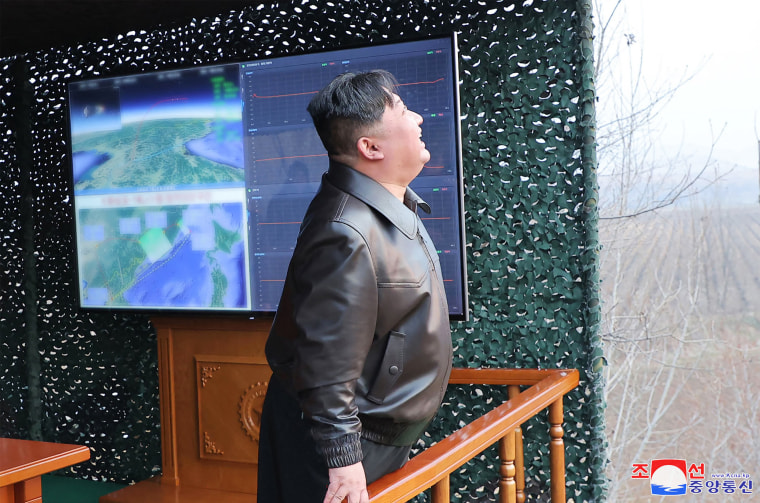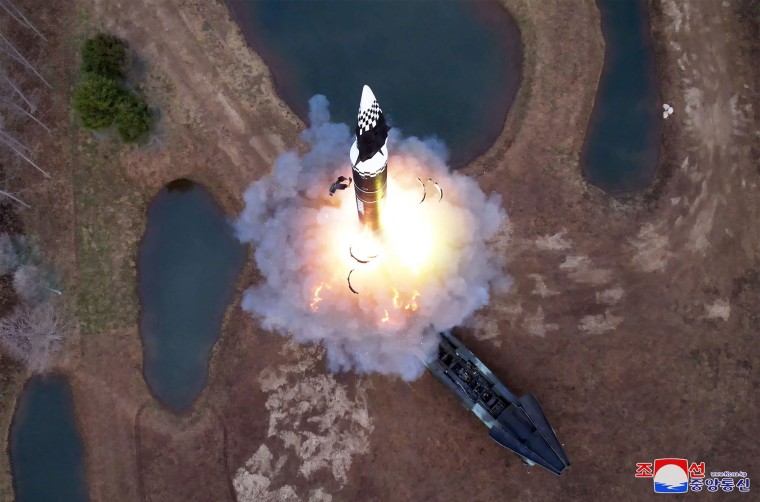North Korea said Wednesday it had tested a new hypersonic intermediate-range missile powered with solid propellants, extending a run in weapons demonstrations that’s deepening a nuclear standoff with neighbors and the United States.
With the supposed success of the test, North Korean leader Kim Jong Un declared his country had acquired the ability to build solid-fuel, nuclear-capable systems for missiles of all ranges as he pursues an arsenal that could viably threaten rivals in Asia and the United States.
The report by North Korean state media came a day after the South Korean and Japanese militaries detected the North launching a missile from near its capital toward its eastern sea.
North Korean state media said the test was supervised by Kim, who described the Hwasong-16B missile as a key piece of his nuclear war deterrent he vowed to further build up to counter his “enemies,” a reference to the United States, South Korea and Japan.
Kim said the North has now developed nuclear-capable, solid-fuel systems for “all the tactical, operational and strategic missiles with various ranges,” the Korean Central News Agency said.
In recent years, North Korea has been focusing on developing more weapons with built-in solid propellants. Those weapons are easier to move and hide and can be made to launch quicker than liquid-propellant missiles, which need to be fueled before launch and cannot stay fueled for long periods of time.
North Korea last year tested a solid-fuel intercontinental ballistic missile for the first time, adding to its arsenal of long-range weapons targeting the U.S. mainland.
The country also has an extensive lineup of short-range and mid-range solid-fuel missiles that can be fired from land vehicles, ships and submarines and are potentially capable of reaching targets throughout South Korea and Japan. The North in recent months demonstrated some of these missiles in drills it described as simulated nuclear strikes while issuing provocative threats of nuclear conflict.
The North has since 2021 also been testing hypersonic weapons designed to exceed five times the speed of sound. If perfected, such systems could potentially pose a challenge to regional missile defense systems because of their speed and maneuverability. However, it’s unclear whether the North’s hypersonic vehicles consistently maintained a desired speed exceeding Mach 5 during tests in 2021 and 2022.

During Tuesday’s test, the missile’s hypersonic glide warhead after being separated from the launch rocket reached a peak altitude of 62 miles and flew about 621 miles while performing various flight maneuvers before landing in waters between the Korean Peninsula and Japan, the KCNA said. The South Korean and Japanese militaries had assessed that the missile flew around 372 miles although Japan’s Defense Ministry announced a similar apogee with the North Korean report.
The North had also tested a purported hypersonic IRBM in January, which came years after it flight-tested liquid-fuel IRBMs. Experts say such weapons if perfected is potentially capable of reaching remote U.S. targets in the Pacific, including the military hub of Guam.
Kim Dong-yub, a professor at the University of North Korean Studies in Seoul, said the missile tested on Tuesday was likely different from the system tested in January, which state media didn’t name but would likely be the Hwasong-16A.
North Korea in previous tests have unveiled two different types of hypersonic vehicles — a conical one and a wedge-shaped one. State media images show that the January launch involved a conical warhead while the wedge-shaped design was used for Tuesday’s launch.
While North Korea had initially tested its hypersonic warheads with liquid-fuel systems, the ability to load them on solid-fuel rockets would allow for faster launches and operation, said Chang Young-keun, a missile expert at South Korea’s Research Institute for National Strategy.
“North Korea, in declaring that it has fully accomplished the nuclear weaponization of its missiles, also emphasized its commitment to arm its hypersonic missiles with nuclear weapons,” Chang said. “North Korea’s development of hypersonic IRBMs targets Guam, which hosts U.S. military bases, and even Alaska.”
Tensions in the region have risen since 2022 as Kim used Russia’s invasion of Ukraine as a distraction to accelerate his testing of missiles and other weapons. The United States and South Korea have responded by expanding their combined training and trilateral drills involving Japan and sharpening their deterrence strategies built around strategic U.S. assets.
While supervising Tuesday’s test, Kim Jong Un called for his country to further expand its nuclear and missile program to acquire “overwhelming power capable of containing and controlling” his enemies, who have “recently run higher fever in boosting their military alliance and staging all sorts of war drills.”
Hours after the launch, Seoul’s Defense Ministry announced that South Korea, the United States and Japan conducted a combined aerial exercise above waters near South Korea’s Jeju island that involved at least one nuclear-capable U.S. B-52 bomber.
The United States in recent months has been increasing its deployment of strategic assets to the region, also including aircraft carriers and missile-firing submarines, in a show of force against North Korea.
